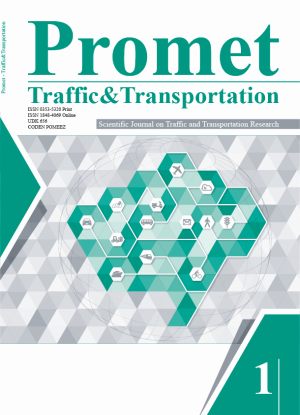Optimal Routing and Charging of Electric Logistics VehiclesBased on Long-Distance Transportation and Dynamic Transportation System
DOI:
https://doi.org/10.7307/ptt.v35i2.54Keywords:
electric logistics vehicle, long-distance distribution, path planning, charging schedulingAbstract
The application of electric vehicles (EVs) in the logistics industry has become more extensive. However, the mileage limitation of electric logistics vehicles (ELVs) and the long-distance distribution of ELVs have become urgent problems. Therefore, this paper proposes a long-distance distribution model for ELVs based on dynamic traffic information considering fleet mileage, distribution time and total distribution cost as the optimisation objectives, thus reasonably planning road selection and charging, and alleviating “mileage anxiety” in the long-distance distribution of ELVs. The model proposed in this paper comprehensively considers the characteristics of the high-speed and low-speed roads, the changes in road traffic flow on weekdays and non-weekdays, the time-of-use electricity price of electric vehicle charging stations (EVCSs) and uses the M/M/s queuing theory model to determine the charging waiting time. Finally, a real traffic network is taken as an example to verify the practicability and effectiveness of this model.
References
Xie F, et al. Long-term strategic planning of inter-city fast charging infrastructure for battery electric vehicles. Transportation Research Part E – Logistics and Transportation Review. 2018;109:261-276. DOI: 10.1016/j.tre.2017.11.014.
Schiffer M, Walther G. Strategic planning of electric logistics fleet networks: A robust location-routing approach. Omega. 2018;80:31-42. DOI: 10.1016/j.omega.2017.09.003.
Pelletier S, Jabali O, Laporte G. 50th anniversary invited article – Goods distribution with electric vehicles: Review and research perspectives. Transportation Science. 2016;50(1):3-22. DOI: 10.1287/trsc.2015.0646.
Yang HM, et al. Electric vehicle route optimization considering time-of-use electricity price by learnable partheno-genetic algorithm. IEEE Transactions on Smart Grid. 2015;6(2):657-666. DOI: 10.1109/TSG.2014.2382684.
Liu JL, Ma ZJ. Multi-depot vehicle routing problem with time windows based on vehicle leasing and sharing. Systems Engineering¬¬-Theory&Practice. 2013;33(3):667-675.
Goeke D. Granular tabu search for the pickup and delivery problem with time windows and electric vehicles. European Journal of Operational Research. 2019;278(3):821-836. DOI: 10.1016/j.ejor.2019.05.010.
Deng YJ, Ma ZJ. Logistics distribution route planning and dis/charging management of electric vehicles considering customer satisfaction level. Operations Research and Management Science. 2021;30(7):136-145.
Rastani S, Yuksel T, Çatay B. Effects of ambient temperature on the route planning of electric freight vehicles. Transportation Research Part D – Transport and Environment. 2019;74:124-141. DOI: 10.1016/j.trd.2019.07.025.
Zhu XN, et al. Logistic optimization for multi depots loading capacitated electric vehicle routing problem from low carbon perspective. IEEE Access. 2020;8:31934-31947. DOI: 10.1109/ACCESS.2020.2971220.
Li Y, et al. Sharing economy to improve routing for urban logistics distribution using electric vehicles. Resources Conservation and Recycling. 2020;153. DOI: 10.1016/j.resconrec.2019.104585.
Bi XW, Tang WKS. Logistical planning for electric vehicles under time-dependent stochastic traffic. IEEE Transactions on Intelligent Transportation Systems. 2019;20(10):3771-3781. DOI: 10.1109/TITS.2018.2883791.
Yang HM, et al. Route selection and charging navigation strategy for electric vehicles employing real-time traffic information perception. Automation of Electric Power Systems. 2017;41(11):106-113. DOI: 10.7500/AEPS20160821005.
Li XH, et al. Spatial-temporal distribution prediction of charging load for electric vehicles based on dynamic traffic information. Power System Protection and Control. 2020;48(1):117-125.
Xing Q, et al. Route planning and charging navigation strategy for electric vehicles based on real-time traffic information. Proceedings of the Chinese Society of Electrical Engineering. 2020;40(2):534-549.
Wang Y, et al. Planning of EVCSs for shared electric vehicle based on dynamic stochastic programming. Power System Technology. 2022.
He N, Zhao SC. Discussion on influencing factors of free-flow travel time in road traffic impedance function. 13th COTA international conference of transportation professionals (CICTP 2013). COTA; 2013. p. 90-97.
Huang J, et al. Destination oriented electric vehicle charging guiding strategy. Power System Technology. 2017;41(7):2173-2181. DOI: 10.13335/j.1000-3673.pst.2016.3116.
Bae S, Kwasinski A. Spatial and temporal model of electric vehicle charging demand. IEEE Transactions on Smart Grid. 2012;3(1):394-403. DOI: 10.1109/TSG.2011.2159278.
Guo G, Xu T. Vehicle rebalancing with charging scheduling in one-way car-sharing systems. IEEE Transactions on Intelligent Transportation Systems. 2022;23(5):4342-4351. DOI: 10.1109/TITS.2020.3043594.
Wang Y, et al. Optimal planning of EVCSs for an electric vehicle fleet in car-sharing business. International Transactions on Electrical Energy Systems. 2021;31(11). DOI: 10.1002/2050-7038.13098.
Amin GR. A comment on modified big-M method to recognize the infeasibility of linear programming models. Knowledge-Based Systems. 2010;23(3):283-284. DOI: 10.1016/j.knosys.2010.01.002.
Lai KX, Illindala M, Subramaniam K. A tri-level optimization model to mitigate coordinated attacks on electric power systems in a cyber-physical environment. Applied Energy. 2019;235:204-218. DOI: 10.1016/j.apenergy.2018.10.077.
Lai KX, Wu X, Zhang L. A MILP optimization model for siting isolation devices in distribution systems with DERs to enhance reliability. International Transactions on Electrical Energy Systems. 2021;31(9):e13006. DOI: 10.1002/2050-7038.13006.
Arroyo JM. Bilevel programming applied to power system vulnerability analysis under multiple contingencies. IET Generation, Transmission & Distribution. 2010;4(2):178-190. DOI: 10.1049/iet-gtd.2009.0098.
Shi WL, et al. Regional power grid LSTM dispatch strategy considering the difference between electric vehicle demand and time-of-use electricity price. Proceedings of the Chinese Society of Electrical Engineering. 2021.
Downloads
Published
How to Cite
Issue
Section
License
Copyright (c) 2023 Yang Wang, Bin Li, Zhenghui Zhao, Kuanwu Tang

This work is licensed under a Creative Commons Attribution-NonCommercial 4.0 International License.







